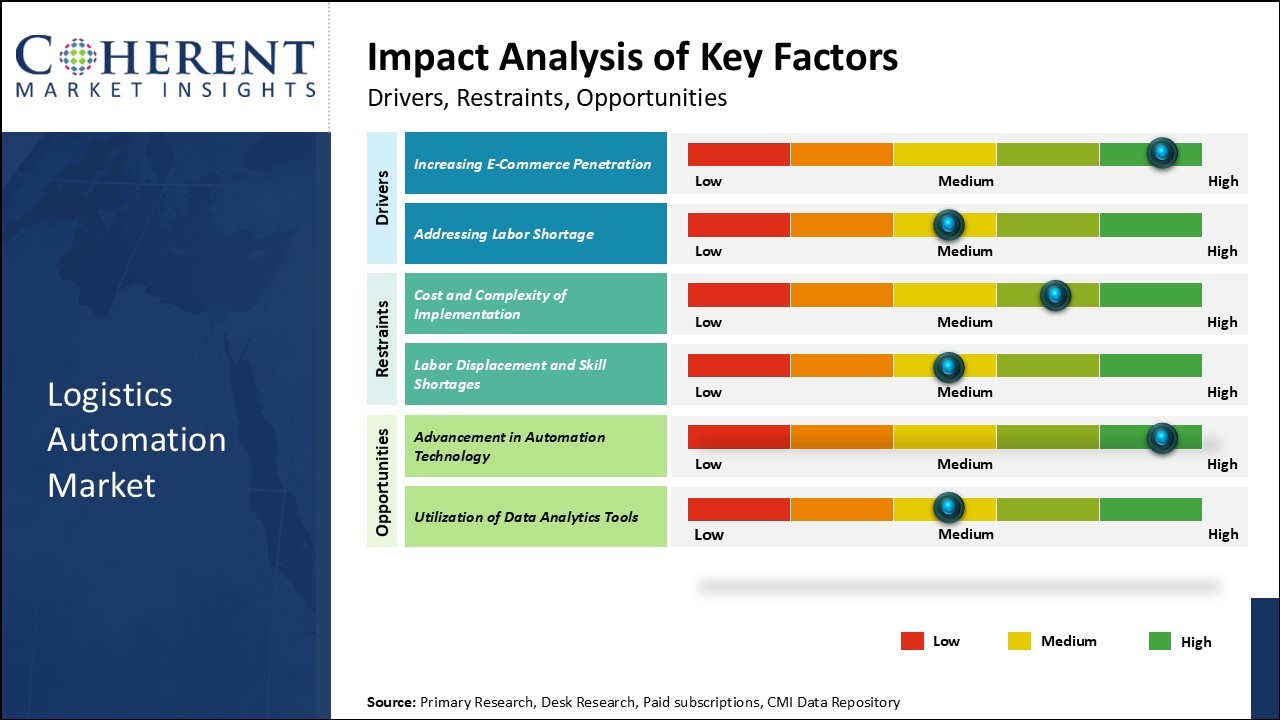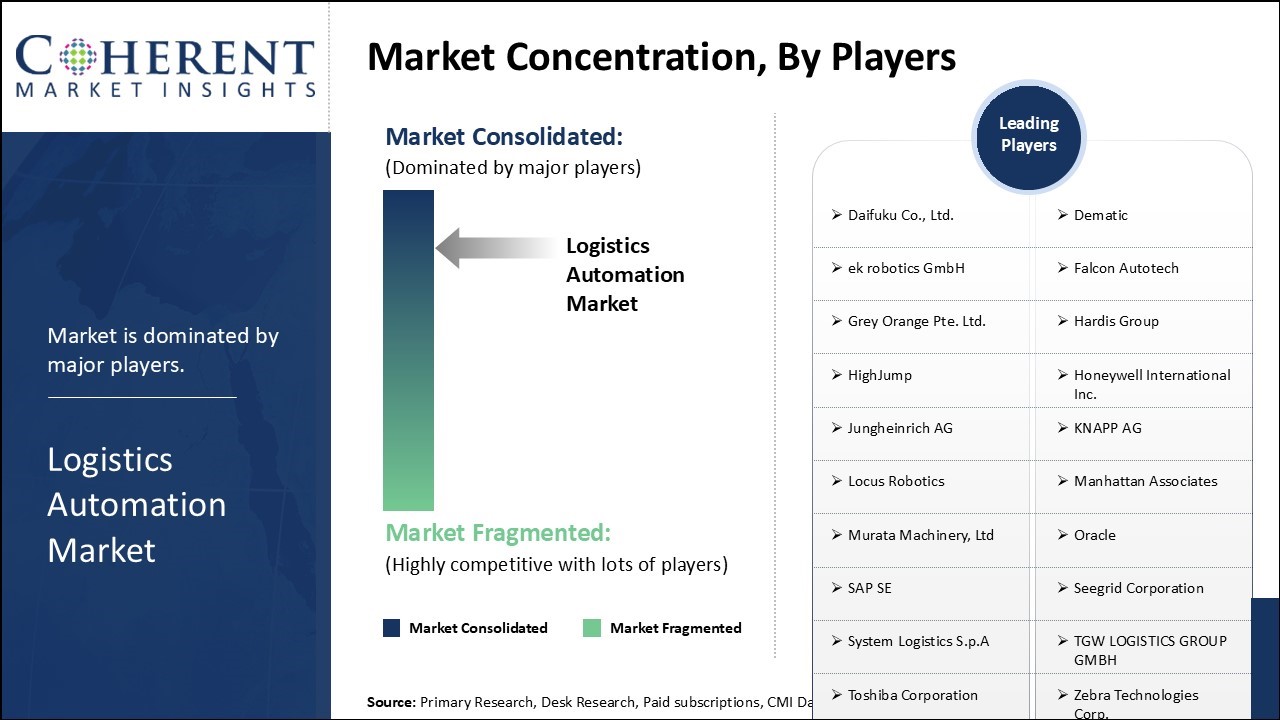
The logistics automation market is estimated to be valued at USD 60.00 Bn in 2025 and is expected to reach USD 130.25 Bn by 2032, exhibiting a compound annual growth rate (CAGR) of 11.7% from 2025 to 2032.

To learn more about this report, Download Free Sample
The logistics automation market is witnessing significant trend of automation and advanced technologies. The industry players are continuously focusing on incorporating new technological advancements such as autonomous vehicles, robotics, internet of things, and analytics solutions to enhance efficiency and optimize logistics operations. Various companies in different industry verticals are increasingly adopting automation in their supply chain and logistics operations to minimize costs, improve productivity and remain competitive.
However, the implementing logistics automation can be costly and complex which is one of the factors restraining the growth of the market.

To learn more about this report, Download Free Sample
The automotive industry's shift toward the electric and hybrid vehicles is fundamentally transforming logistics automation needs, as these vehicles require complex components—such as lithium-ion batteries and electric drivetrains—that involve stricter handling, storage, and transport protocols. This shift is accelerating the adoption of advanced warehouse automation and intelligent supply chain systems.
For instance, according to the International Energy Agency, the global electric car sales topped 17 million in 2024, rising by more than 25%, highlighting the scale at which logistics infrastructure must adapt.
The hardware segment is expected to contribute the highest share of 50.9% in 2025 owing to its critical importance in logistics automation. Hardware forms the core foundation for automation of logistics operations and includes devices such as automated conveyor systems, automated guided vehicles, automated storage and retrieval systems, robotics, and more.
These hardware systems are designed specifically to automate material handling processes and optimize workflow in warehouses, distribution centers and logistics facilities. The integration of advanced sensors, actuators and control mechanisms within hardware enables capabilities like object detection, navigation, sorting and tracking of shipments and inventory in real-time.
The small & medium enterprises segment is expected to contribute the highest share of 64.4% in 2025 owing to cost-related drivers. While large enterprises are also actively automating their logistics chains, the promise of relatively quicker paybacks makes automation more valuable for SMEs.
These companies have limited financial resources at their disposal and see logistics automation as a way to boost productivity, reduce manual errors and streamline operations with limited investments. Automation solutions tailored for SMEs by vendors are easy to implement and maintain. The capex costs associated with hardware procurement and software licensing can also be better absorbed by smaller companies through consumption-based pricing models.
The retail & e-commerce segment is expected to contribute the highest share of 34.6% in 2025 driven by surging distribution demands and rising customer expectations. As online shopping continues to grow rapidly, retailers are facing unprecedented pressure to process higher order volumes throughput their distribution networks on time.
This has necessitated significant upgrades to existing fulfillment infrastructure incorporating cutting-edge automation technologies. Automated distribution and shipping facilities allow retailers to increase picking rates manifold and achieve extremely quick turnaround times. New fulfillment models like micro-warehouses further accelerate speedy last-mile deliveries.
|
Manufacturers |
Manufacturing Facilities |
|
Daifuku Co., Ltd. |
Daifuku Co., Ltd. is one of the dominant players with manufacturing plants primarily in Japan, the U.S., China, and Europe. Their main production facility in Nagoya, Japan, is equipped to produce a wide array of automated material handling equipment, including conveyor systems and sortation solutions. The U.S. facility in Georgia focuses on Automated Storage and Retrieval Systems (AS/RS) and warehouse control software. Daifuku's combined production capacity stands at approximately 10,000 units annually, allowing them to service high volumes, particularly in ecommerce and manufacturing sectors. |
|
Vanderlande Industries |
Vanderlande Industries, a Dutch company now part of Toyota Industries Corporation, operates multiple manufacturing facilities across Europe, the U.S., and Asia. Their primary production plants in the Netherlands and Germany specialize in automated baggage handling systems, sorters, and parcel handling equipment. The company’s facility in Suzhou, China, has been expanded recently to focus on logistics automation solutions for the Asian market, with an estimated production capacity exceeding 7,000 equipment units per year. |
Uncover macros and micros vetted on 75+ parameters: Get instant access to report

To learn more about this report, Download Free Sample
North America has established itself as the dominant region with a projected market share of 35.0% in 2025 in the global logistics automation market. The region is home to leading logistics and supply chain companies that have heavily invested in automation technologies across warehouses and distribution centers. U.S. and Canadian logistics giants have automated key operations such as material handling, inventory tracking, and order fulfillment using robotics, conveyor systems, and warehouse management software.
For instance, in September 2024, according to IBM report, the automotive sector was the top adopter of industrial robots in the U.S. last year, accounting for 33% of all installations—illustrating how industries with complex logistics needs are driving automation demand across both production and supply chain environments.
Asia Pacific region is poised to be the fastest growing logistics automation market with a CAGR of 13.8%. Countries like China, India, Japan, and South Korea are experiencing strong growth in both manufacturing and e-commerce, driven by a rapidly expanding middle class. This surge is generating unprecedented volumes of goods movement and warehouse activities, fueling demand for advanced logistics automation solutions.
For instance, according to the International Federation of Robotics, 73% of all newly deployed industrial robots were installed in Asia underscoring the region’s rapid shift toward automation across manufacturing and logistics sectors.
The U.S. leads in logistics automation driven by its advanced technological infrastructure and the presence of the major global e-commerce and logistics companies. Continuous innovation in robotics, AI, and warehouse management systems fuels demand, while companies focus on enhancing efficiency and reducing labor costs to meet growing consumer expectations for fast delivery.
China's rapid industrialization and booming e-commerce sector are primary drivers for logistics automation. The country’s commitment to modernizing its supply chain infrastructure, coupled with government support for smart manufacturing and automation, accelerates adoption of cutting-edge technologies in warehouses and distribution centers.
Germany’s strong manufacturing base and its central position in European trade make it a key player in logistics automation. The country prioritizes precision engineering and Industry 4.0 initiatives, fostering integration of automated systems in logistics to improve supply chain transparency, reliability, and operational excellence.
Japan’s emphasis on robotics and automation as part of its broader technological advancement strategy significantly impacts its logistics sector. Faced with a shrinking workforce, Japanese companies adopt automation to maintain productivity and competitiveness, driving innovation in automated material handling and intelligent warehouse solutions.
|
Brand, Solution |
Pricing Model in USD |
|
SAP Extended Warehouse Management (EWM), On-premises/Cloud, License + Implementation |
100,000 - 5 million and above |
|
Manhattan Associates, Manhattan WMS, Subscription + License |
50,000 - 3 million and above |
|
Blue Yonder (JDA), Luminate WMS, SaaS Subscription |
20,000 - 1 million+ annually |
|
Oracle WMS Cloud, Cloud-based WMS, Subscription |
10,000 - 500,000 annually |
|
HighJump (Scan), WMS, License + Maintenance |
30,000 - 2 million and above |
Uncover macros and micros vetted on 75+ parameters: Get instant access to report
| Report Coverage | Details | ||
|---|---|---|---|
| Base Year: | 2024 | Market Size in 2025: | USD 60.00 Bn |
| Historical Data for: | 2020 To 2024 | Forecast Period: | 2025 To 2032 |
| Forecast Period 2025 to 2032 CAGR: | 11.7% | 2032 Value Projection: | USD 130.25 Bn |
| Geographies covered: |
|
||
| Segments covered: |
|
||
| Companies covered: |
Daifuku Co., Ltd., Dematic, ek robotics GmbH, Falcon Autotech, Grey Orange Pte. Ltd., Hardis Group, HighJump, Honeywell International Inc., Jungheinrich AG, KNAPP AG, Locus Robotics, Manhattan Associates, Murata Machinery, Ltd, Oracle, SAP SE, Seegrid Corporation, System Logistics S.p.A, TGW LOGISTICS GROUP GMBH, Toshiba Corporation, and Zebra Technologies Corp. |
||
| Growth Drivers: |
|
||
| Restraints & Challenges: |
|
||
Uncover macros and micros vetted on 75+ parameters: Get instant access to report
*Definition: The logistics automation market involves the use of automated systems and software to optimize logistics operations and help companies efficiently move materials and goods through the supply chain. Logistics automation utilizes technologies like industrial robots, autonomous mobile robots, sensors, machine vision, automated storage and retrieval systems, and big data analytics to automate processes like material handling, warehouse management, transportation management, order processing and fulfilment, fleet management, and inventory management with minimal or no human intervention for better productivity, visibility and cost savings.
Share
Share
About Author
Gautam Mahajan is a Research Consultant with 5+ years of experience in market research and consulting. He excels in analyzing market engineering, market trends, competitive landscapes, and technological developments. He specializes in both primary and secondary research, as well as strategic consulting across diverse sectors.
Missing comfort of reading report in your local language? Find your preferred language :
Transform your Strategy with Exclusive Trending Reports :
Frequently Asked Questions
Joining thousands of companies around the world committed to making the Excellent Business Solutions.
View All Our Clients